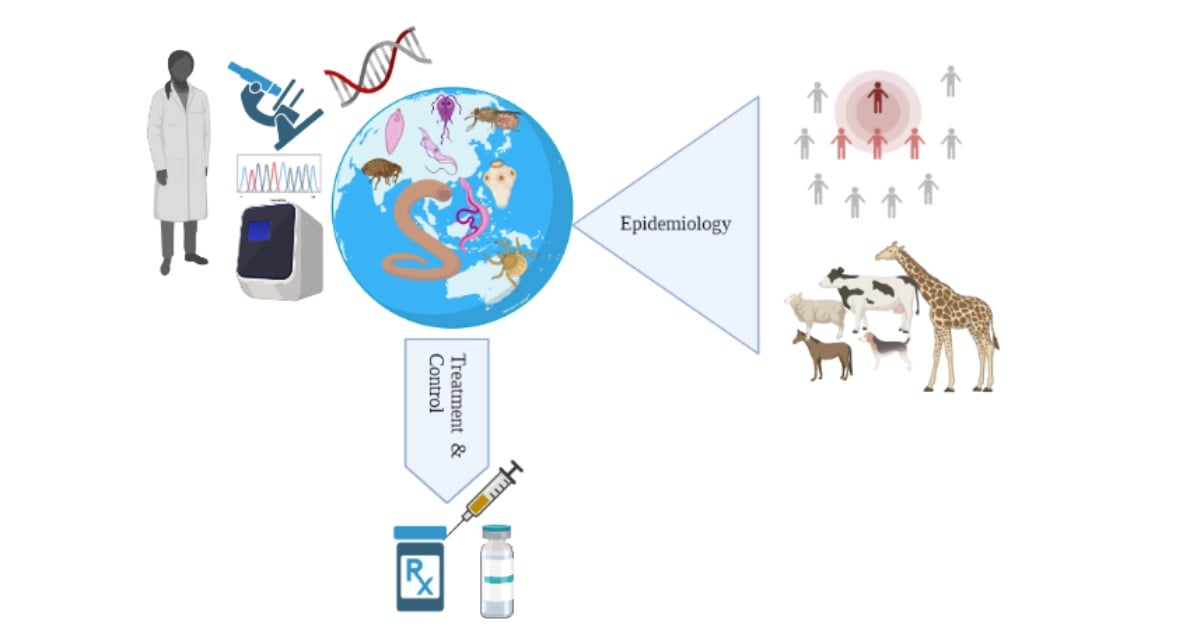Parasites: Epidemiology, Treatment and Control: 2nd Edition
A special issue of Pathogens (ISSN 2076-0817). This special issue belongs to the section "Parasitic Pathogens".
Deadline for manuscript submissions: closed (30 April 2024) | Viewed by 2722

Special Issue Editors
Interests: helminth infections; anthelmintic drug resistance; host–parasite interaction; anthelmintic drug discovery; biomarkers for host resistance to parasites; sustainable parasite control strategies
Special Issues, Collections and Topics in MDPI journals
Interests: helminth infections; protozoan infections; parasite–nutrition interactions; gut health and microbiota; nutraceuticals and nonchemical approaches to controlling gut pathogens
Special Issues, Collections and Topics in MDPI journals
Special Issue Information
Dear Colleagues,
Parasites are one of the most significant health and welfare concerns for humans and animals and cause losses of billions of dollars annually in terms of reduced productivity and treatment and control costs. Parasitic diseases are caused by a wide variety of endo-(helminths, protozoa) and ectoparasites (for example ticks, lice, and flies) in both humans and animals. Parasites have been a primary focus of research in production and companion animals due to the higher rates of morbidity and mortality associated with certain parasitic infections along with reduced farm profitability in the case of production animals. In addition, parasitic zoonoses are one of the major public health concerns throughout the world; for example, soil-transmitted helminths infect more than 1.5 billion people (24% of the world population) worldwide. The treatment of parasitic infections has heavily relied on the use of antiparasitic drugs; however, rapidly developing drug resistance has been a big challenge. With fewer success stories in using vaccines against parasites, the development of sustainable control strategies has been challenging. Parasitology researchers are conducting extensive research to understand parasite biology, the prevalence and transmission patterns of parasitic diseases in the face of climate change, and the pathogenesis of parasitic infections in addition to developing sustainable treatment and control strategies.
Therefore, in this Special Issue of MDPI Pathogens, we invite parasitology researchers to submit high-quality research publications, including in the form of reviews and original research articles, within the area of epidemiology, treatment, and control of parasitic diseases in both humans and animals across the globe. This Special Issue will provide a platform to readers seeking a comprehensive overview and the latest knowledge and information regarding the diversity of parasitology research.
Dr. Ali Raza
Dr. Andrew Richard Williams
Guest Editors
Manuscript Submission Information
Manuscripts should be submitted online at www.mdpi.com by registering and logging in to this website. Once you are registered, click here to go to the submission form. Manuscripts can be submitted until the deadline. All submissions that pass pre-check are peer-reviewed. Accepted papers will be published continuously in the journal (as soon as accepted) and will be listed together on the special issue website. Research articles, review articles as well as short communications are invited. For planned papers, a title and short abstract (about 100 words) can be sent to the Editorial Office for announcement on this website.
Submitted manuscripts should not have been published previously, nor be under consideration for publication elsewhere (except conference proceedings papers). All manuscripts are thoroughly refereed through a single-blind peer-review process. A guide for authors and other relevant information for submission of manuscripts is available on the Instructions for Authors page. Pathogens is an international peer-reviewed open access monthly journal published by MDPI.
Please visit the Instructions for Authors page before submitting a manuscript. The Article Processing Charge (APC) for publication in this open access journal is 2700 CHF (Swiss Francs). Submitted papers should be well formatted and use good English. Authors may use MDPI's English editing service prior to publication or during author revisions.
Keywords
- endoparasites
- ectoparasites
- zoonoses
- epidemiology
- treatment
- control
Related Special Issue
- Parasites: Epidemiology, Treatment and Control in Pathogens (13 articles)







